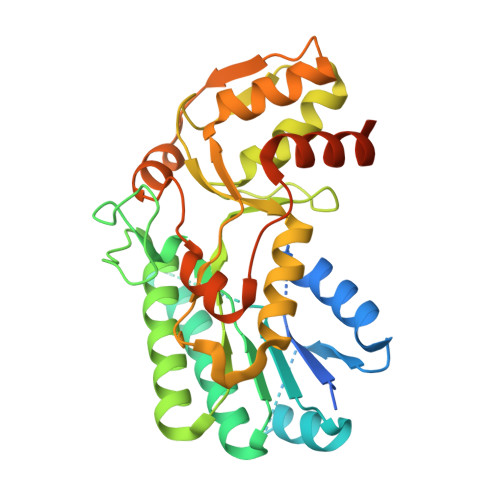Binding of NAD+ and L-Threonine Induces Stepwise Structural and Flexibility Changes in Cupriavidus necator L-Threonine Dehydrogenase
Nakano, S., Okazaki, S., Tokiwa, H., Asano, Y.(2014) J Biological Chem 289: 10445-10454
- PubMed: 24558034
- DOI: https://doi.org/10.1074/jbc.M113.540773
- Primary Citation of Related Structures:
3WMW, 3WMX - PubMed Abstract:
Crystal structures of short chain dehydrogenase-like L-threonine dehydrogenase from Cupriavidus necator (CnThrDH) in the apo and holo forms were determined at 2.25 and 2.5 Å, respectively. Structural comparison between the apo and holo forms revealed that four regions of CnThrDH adopted flexible conformations when neither NAD(+) nor L-Thr were bound: residues 38-59, residues 77-87, residues 180-186, and the catalytic domain. Molecular dynamics simulations performed at the 50-ns time scale revealed that three of these regions remained flexible when NAD(+) was bound to CnThrDH: residues 80-87, residues 180-186, and the catalytic domain. Molecular dynamics simulations also indicated that the structure of CnThrDH changed from a closed form to an open form upon NAD(+) binding. The newly formed cleft in the open form may function as a conduit for substrate entry and product exit. These computational results led us to hypothesize that the CnThrDH reaction progresses by switching between the closed and open forms. Enzyme kinetics parameters of the L80G, G184A, and T186N variants also supported this prediction: the kcat/Km, L-Thr value of the variants was >330-fold lower than that of the wild type; this decrease suggested that the variants mostly adopt the open form when L-Thr is bound to the active site. These results are summarized in a schematic model of the stepwise changes in flexibility and structure that occur in CnThrDH upon binding of NAD(+) and L-Thr. This demonstrates that the dynamical structural changes of short chain dehydrogenase-like L-threonine dehydrogenase are important for the reactivity and specificity of the enzyme.
- Biotechnology Research Center and Department of Biotechnology, Toyama Prefectural University, 5180 Kurokawa, Imizu, Toyama 939-0398, Japan; Asano Active Enzyme Molecule Project, ERATO, JST, 5180 Kurokawa, Imizu, Toyama 939-0398, Japan.
Organizational Affiliation:

















